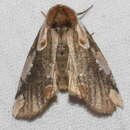Conservation Status
fornecido por University of Alberta Museums
A fairly common, widespread species; no concerns.
- licença
- cc-by-nc
- direitos autorais
- University of Alberta Museums
Cyclicity
fornecido por University of Alberta Museums
In Alberta it is on the wing in spring, from late April through early June.
- licença
- cc-by-nc
- direitos autorais
- University of Alberta Museums
Distribution
fornecido por University of Alberta Museums
Across southern Canada from Newfoundland to Vancouver Island, and south to the Gulf of Mexico. In Alberta it has been collected in the aspen parklands, the southern boreal forest (north to Lac la Biche), and in the foothills and at lower elevations in the mountains.
- licença
- cc-by-nc
- direitos autorais
- University of Alberta Museums
General Description
fornecido por University of Alberta Museums
A medium-sized moth (4.0-4.5 cm wingspan). It occurs in two very different appearing forms, with the dark form by far the less common of the two. The more common "normal" form has pink-white patches at the base, midpoint along the costa and at the apex, and a coppery brown spot at the anal angle. The hindwings are brown with an indistinct discal mark. The less common form (pennsylvanica) is much darker, blackish near the wing base, and entirely lacks the pink-white patches. The outline of the apical patch is visible, as is the coppery-brown spot at the anal angle. The most prominent marking is the short black line on the lower edge of the apical patch. Antennae are filiform and the sexes are similar. The normal form is unlikely to be mistaken for any other Alberta moth.
- licença
- cc-by-nc
- direitos autorais
- University of Alberta Museums
Habitat
fornecido por University of Alberta Museums
Mature mesic mixedwood and deciduous woodland with dogwood understory.
- licença
- cc-by-nc
- direitos autorais
- University of Alberta Museums
Life Cycle
fornecido por University of Alberta Museums
This is one of the first moths to emerge in the spring. The adults are attracted to light.
- licença
- cc-by-nc
- direitos autorais
- University of Alberta Museums
Trophic Strategy
fornecido por University of Alberta Museums
The larvae use various dogwoods (Cornus sp.) as hosts. Jones (1951) also lists Rubus sp. (blackberry and raspberry) as hosts of pudens, but this is unlikely and should be verified.
- licença
- cc-by-nc
- direitos autorais
- University of Alberta Museums
Euthyatira pudens
(
Inglês
)
fornecido por wikipedia EN
Euthyatira pudens, the dogwood thyatirid moth or peach-blossom moth, is a moth of the family Drepanidae. The species was first described by Achille Guenée in 1852. It is found in North America, where it ranges across southern Canada, south to the Gulf of Mexico.[1] The habitat consists of moist forests and riparian zones along creeks at low to middle elevations.
The wingspan is 40–45 mm. There are two distinct forms. The common form has pink-white patches at the base, along the costa and at the apex. There is a coppery-brown spot at the anal angle. The hindwings are brown. Form pennsylvanica is darker, blackish near the wing base, and does not have the pink-white patches. Adults are on wing in spring in one generation per year.
The larvae feed on Cornus species.[2] The larvae are dark gray black with a white ventral area.[3]
References

- licença
- cc-by-sa-3.0
- direitos autorais
- Wikipedia authors and editors
Euthyatira pudens: Brief Summary
(
Inglês
)
fornecido por wikipedia EN
Euthyatira pudens, the dogwood thyatirid moth or peach-blossom moth, is a moth of the family Drepanidae. The species was first described by Achille Guenée in 1852. It is found in North America, where it ranges across southern Canada, south to the Gulf of Mexico. The habitat consists of moist forests and riparian zones along creeks at low to middle elevations.
The wingspan is 40–45 mm. There are two distinct forms. The common form has pink-white patches at the base, along the costa and at the apex. There is a coppery-brown spot at the anal angle. The hindwings are brown. Form pennsylvanica is darker, blackish near the wing base, and does not have the pink-white patches. Adults are on wing in spring in one generation per year.
The larvae feed on Cornus species. The larvae are dark gray black with a white ventral area.
- licença
- cc-by-sa-3.0
- direitos autorais
- Wikipedia authors and editors
Euthyatira pudens
(
Neerlandês; Flamengo
)
fornecido por wikipedia NL
Insecten Euthyatira pudens is een vlinder uit de familie van de eenstaartjes (Drepanidae).[1] De wetenschappelijke naam van de soort is voor het eerst geldig gepubliceerd in 1852 door Guenée.
Bronnen, noten en/of referenties Geplaatst op:
30-03-2013
Dit artikel is een beginnetje over biologie. U wordt uitgenodigd om op bewerken te klikken om uw kennis aan dit artikel toe te voegen.

- licença
- cc-by-sa-3.0
- direitos autorais
- Wikipedia-auteurs en -editors

